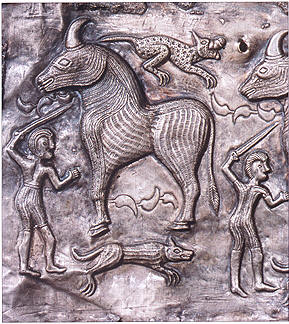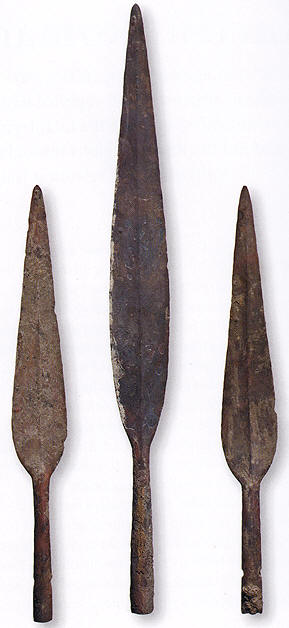Ancient Celtic Weapons
The warrior Celts (c.600BC—AD50)
were famed for their ferociousness and tenacity in
battle, and even received grudging respect from
their Roman adversaries. The early Celts fought
mainly on foot (later in chariots and on horseback),
and relied heavily on the awesome psychological and
physical impact of a massed charge of their
warriors. Armed with either sword or spear and
protected with little more than a shield or helmet,
they defeated the mighty Roman legions and, in
390Bc, even sacked Rome itself.
Symbolism of the
Celtic Sword
The Celtic sword symbolized to
its owner power, strength, honour and ultimate glory
in battle. The fine quality and extraordinary skills
required to produce these swords meant that they
were extremely expensive and normally reserved for
nobles and chieftains. The sword was often buried
with its owner amongst his many other possessions,
or symbolically thrown into water as a gift to the
gods or spirits.
The Falcata
 With
a large inwardly curving, single-edged blade rather
like a kukri (heavy, curved Nepalese knife), the
falcata was an extremely devastating weapon. Hilts
were iron, hook-shaped and sometimes decorated with
stylized horse or bird-head pommels. The origin of
the falcata was
pre-Roman and it is likely to have been a
development of the ancient Greek sickle-shaped
sword, or kopis. The sword could deliver a very
powerful blow, something akin to an axe strike but
with the slashing capabilities of a conventional
sword. Contemporary Roman writers often describe how
the falcata had the capacity to split both shield
and helmet. The Celts of Hispania (Spain) were said
to be the most feared exponents of this sword and it
was a common weapon encountered by Roman forces
during the early years of the Roman Republic
(509—l24BC). With
a large inwardly curving, single-edged blade rather
like a kukri (heavy, curved Nepalese knife), the
falcata was an extremely devastating weapon. Hilts
were iron, hook-shaped and sometimes decorated with
stylized horse or bird-head pommels. The origin of
the falcata was
pre-Roman and it is likely to have been a
development of the ancient Greek sickle-shaped
sword, or kopis. The sword could deliver a very
powerful blow, something akin to an axe strike but
with the slashing capabilities of a conventional
sword. Contemporary Roman writers often describe how
the falcata had the capacity to split both shield
and helmet. The Celts of Hispania (Spain) were said
to be the most feared exponents of this sword and it
was a common weapon encountered by Roman forces
during the early years of the Roman Republic
(509—l24BC).
ABOVE:
Relief plaque, made from copper with silver and gold
plating, of a warrior wielding a long-bladed Celtic
sword from the 1st
century AD.
The Manufacture
of the Falcata
During this possibly
unique process of manufacture, various forged steel
plates were buried in the ground, usually for more
than three years, and allowed to corrode. They would
then be dug up and any weak or spurious metal would
be separated and discarded. Any remaining good steel
was reforged again through the traditional Celtic
method of pattern welding
—
the practice of
forming a blade from several metal pieces of
differing composition. The blades were then
forge-welded together and manipulated to form a
pattern, making it considerably harder. In response
to these much tougher blades, the Roman legions
redesigned their shields and armour to give them
more protection. The introduction of the Roman
gladius, or short sword, was said to be a direct
reaction to the Roman soldiers’ battlefield
experience of the falcata.
Longer Celtic
Swords
The growing use of
cavalry and, later, the war chariot meant that
Celtic warriors needed a longer sword to effectively
reach down and strike at an opponent.
These long swords,
with an average blade length of around 70cm
(27.5in), had wood, bone or horn hilts, with blades
manufactured in iron or steel. Scabbards were
normally constructed from plates of iron and
suspended from a belt of iron links.
The Celts were one of the first European peoples to
discover how to smelt iron, and by the time they
made contact with the Romans they had developed
consistent methods of producing better balanced
swords that were more resilient and longer. It is
therefore curious that the Roman writer Polybius (c.203—120Bc)
reported that, at the Battle of Telamon (225Bc), the
Gauls had carried inferior iron swords which bent at
the first stroke and had to be straightened with the
foot against the ground. This is also mentioned by
Plutarch
(c.AD46—127),
but it seems more likely that this was Roman
propaganda, as subsequent archaeological testing of
excavated Celtic sword blades indicates that the
quality of the iron and steel was quite exceptional.
The Swords of the La Tène Culture
Archaeological finds from the La Tène settlement on
the north edge of Lake Neuchâtel in Switzerland,
dating to around 500—1 BC, highlight the Celtic
genius for creating swords with complex abstract and
organic decoration on both the hilt and the
scabbard. Blades were double-edged and straight, and
made from pattern-welded iron or steel. They are
found in both long and short versions. Many finely
worked hilts also feature human heads and other
anthropomorphic and zoomorphic motifs.

RIGHT
A 1st or 2nd century ec sword and scabbard from La
Tène in Switzerland.
 The
Spear The
Spear
A standard battlefield weapon for the Celtic
warrior, the Celtic spear or javelin normally
comprised an ash wood pole around 2m (6.5ft) in
length, fitted with a large iron, leaf-shaped and
socketed spearhead.
Following military experience gained after initial
contact with the Roman armies from the 1st century
AD, the Celts changed the design of their spearheads
so that they possessed a narrower profile. This was
a reaction to the Roman use of protective body
armour and the need to find a spear that could
effectively puncture their plate. Spears and
javelins were also carried in bunches by young
warriors, or “gaesatae”. These were paid mercenaries
who had gained a fearsome reputation for their
bravery. Once they had thrown all the spears at the
enemy, they would retrieve them from the ground or
their opponents’ bodies.
Right:
Three Celtic spearheads from the La Tène period,
each with a leaf-shaped, finely ridged, slightly
bent blade. Two of the examples have holes in the
socket for attaching the head to the shaft.
|